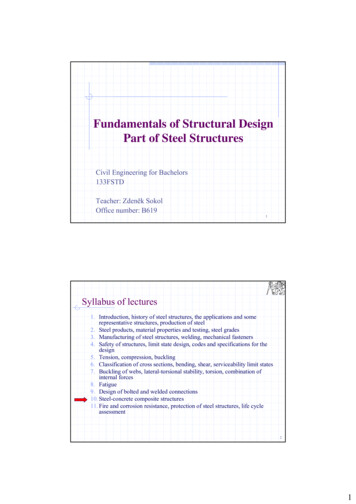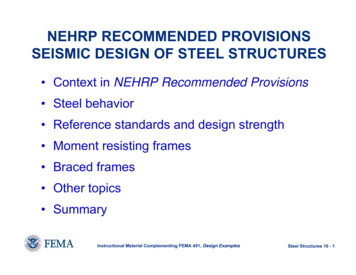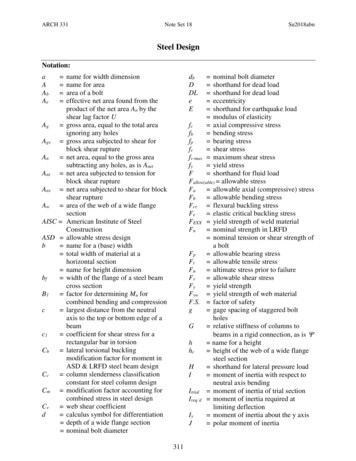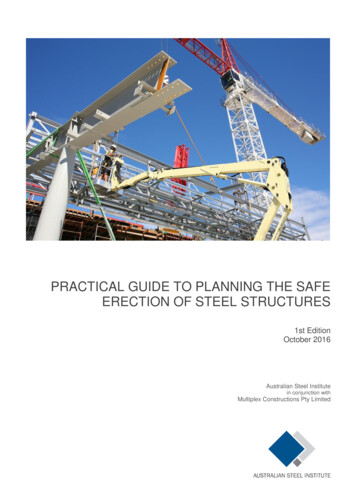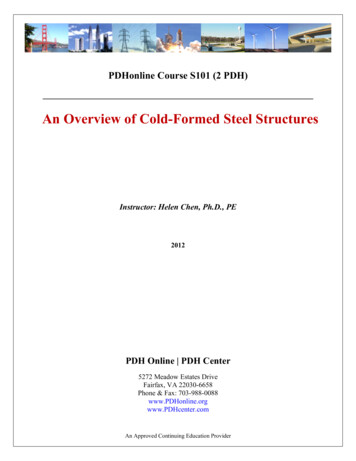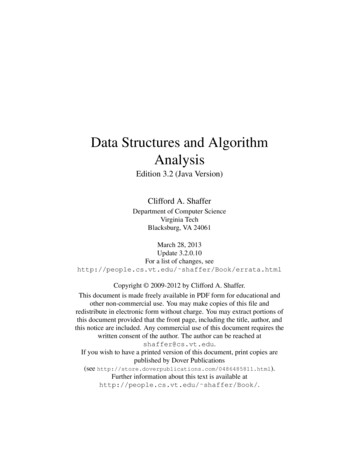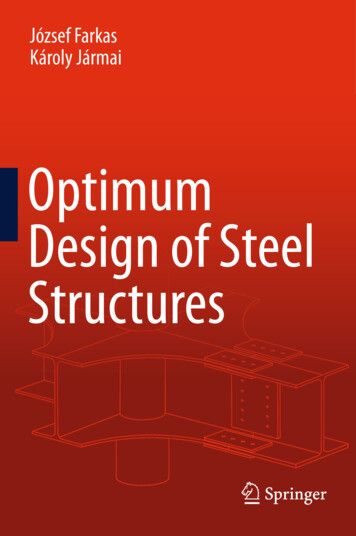
Transcription
József FarkasKároly JármaiOptimumDesign of SteelStructures
Optimum Design of Steel Structures
József Farkas and Károly JármaiOptimum Design of SteelStructuresABC
Dr. József FarkasProfessor Emeritus of Metal StructuresUniversity of MiskolcHungaryDr. Károly JármaiProfessor of Structural EngineeringUniversity of MiskolcHungaryISBN 978-3-642-36867-7ISBN 978-3-642-36868-4DOI 10.1007/978-3-642-36868-4Springer Heidelberg New York Dordrecht London(eBook)Library of Congress Control Number: 2013932222c Springer-Verlag Berlin Heidelberg 2013 This work is subject to copyright. All rights are reserved by the Publisher, whether the whole or part ofthe material is concerned, specifically the rights of translation, reprinting, reuse of illustrations, recitation,broadcasting, reproduction on microfilms or in any other physical way, and transmission or informationstorage and retrieval, electronic adaptation, computer software, or by similar or dissimilar methodologynow known or hereafter developed. Exempted from this legal reservation are brief excerpts in connectionwith reviews or scholarly analysis or material supplied specifically for the purpose of being enteredand executed on a computer system, for exclusive use by the purchaser of the work. Duplication ofthis publication or parts thereof is permitted only under the provisions of the Copyright Law of thePublisher’s location, in its current version, and permission for use must always be obtained from Springer.Permissions for use may be obtained through RightsLink at the Copyright Clearance Center. Violationsare liable to prosecution under the respective Copyright Law.The use of general descriptive names, registered names, trademarks, service marks, etc. in this publicationdoes not imply, even in the absence of a specific statement, that such names are exempt from the relevantprotective laws and regulations and therefore free for general use.While the advice and information in this book are believed to be true and accurate at the date of publication, neither the authors nor the editors nor the publisher can accept any legal responsibility for anyerrors or omissions that may be made. The publisher makes no warranty, express or implied, with respectto the material contained herein.Printed on acid-free paperSpringer is part of Springer Science Business Media (www.springer.com)
PrefaceThe cost plays an important role in the design of engineering structures. This rolecan be illustrated by an example. In the design of a crossing over a big river thedesigner has two possibilities: design a number of small-span bridges with anumber of basements or build a large-span bridge with only two basements. Thecost comparison helps designers to select the cheaper version since the cost ofbasements depends on the quality of soil.In the case of welded structures the cost comparison helps to select the mosteconomic structural version since the welding is an expensive fabricationtechnology. Our research has been focused on the use of the optimum designmethods to minimize the cost of welded structures. This systematic researchresulted in optimized structural types using realistic numerical problems.This book contains studies worked out during last five years and is acontinuation of or books published in years 1984, 1997, 2003 and 2008. Studieson beams, tubular trusses, frames, stiffened plates and shells are grouped inseparate chapters. Chapter 1 gives a survey on our experiences in the field ofstructural optimization. Separate chapters deal with the mathematical functionminimization methods and the cost calculation.Our aim is to transfer the results of our research relating to the optimum designof steel structures, the ways to select the most suitable structural versions. Thistransfer is enabled by abstracts and conclusions of each section.The following studies on the optimum design for minimum weight or cost canbe brought into prominence: Chapter 4: fire design of a welded box beam, Chapter5: transmission line tower constructed as a welded tubular truss, Chapter 6:earthquake-resistant design of braced frames, Chapter 7: storage tank roofconstructed from welded stiffened sectorial plates, Chapter 8: ring-stiffenedcylindrical and conical shells.Structural optimization is a design system for searching better solutions, whichbetter fulfil engineering requirements. The main requirements of a modern loadcarrying structure are the safety, fitness for production and economy. The safetyand producibility are guaranteed by design and fabrication constraints, andeconomy can be achieved by minimization of a cost function.The main aim of this book is to give designers and fabricators aspects forselection of the best structural solution. A lot of structural versions fulfil thedesign and fabrication constraints and designers should select from thesepossibilities the best ones. A suitable cost function helps this selection, since amodern structure should be not only safe and fit for production but alsoeconomic.
VIPrefaceIn most cases, treated in this book, much more unknowns should be varied tofind the best solution. In these cases one needs special mathematical methods,some of them are treated in this book as well.The optimum design procedure can be formulated mathematically as follows:the objective function should be minimizedf ( x ) min, x (x1 ,., xn )subject to constraintsg j ( x ) 0 , j 1. pwhere n is the number of unknowns and p is the number of constraints.The solution of this constrained function minimization problem needs effectivemathematical methods.The above description shows that the structural optimization has four maincomponents:(1) design constraints relate to stress, stability, deformation, eigenfrequency,damping,(2) fabrication constraints formulate the limitation of residual weldingdistortions, requirements for welding technology, limitations of platethicknesses and main structural dimensions, definition of available profileseries,(3) a cost function is formulated according to the fabrication sequence andcontains the cost of materials, assembly, welding, cutting and painting,(4) mathematical methods.In our systematic research we have developed suitable means for these maincomponents. Design constraints are formulated according to relevant Eurocodes ordesign rules of American Petroleum Institute (API), Det Norske Veritas (DNV)and European Convention for Constructional Steelwork (ECCS).We have worked out a calculation method for residual welding stresses anddistortions, for the cost function we have created a calculation method mainly forwelded structures and we use several effective mathematical algorithms.We have solved a lot of structural optimization problems for various structuralmodels. Since these models are the main components of industrial structures,designers can use them in their work. The cost estimation in design stage is a goodbasis for the comparison of candidate structural versions.Our structural models of welded I- and box-beams, tubular trusses, steelframes, stiffened plates and shells can be used in all industrial applications i.e. inbridges, buildings, roofs, columns, towers, ships, cranes, offshore structures, beltconveyor bridges, machine structures, vehicles, etc.Since the functions are highly nonlinear only numerical problems can betreated. Therefore, the conclusions are not completely general. In spite of this thesolutions give valuable aspects for optimum design, because the numerical dataare selected realistically.The first step of the optimization procedure is the selection of variables.For this selection we need to know the main characteristics of a typical structure as follows: materials, loads, geometry, topology, profiles, fabrication
PrefaceVIItechnology, joints, costs. The better solutions can be obtained by changing thesecharacteristics.Summarizing: the general aspect of our book is the cost comparison, which isan effective means to select the most suitable structural versions.We participate continuously in the following conference series: AnnualAssemblies International Institute of Welding (IIW), World Congresses of ISSMO(International Society of Structural and Multidisciplinary Optimization), EurosteelEuropean Conferences of Steel Structures, Tubular Structures Symposia(organized by the IIW subcommission XV-E).Beside the Conference Proceedings, we publish our studies also in well-knowninternational engineering journals i.e. Structural and Multidisciplinary Optimization,Welding in the World, Computers and Structures, Engineering Optimization,Engineering Structures, Thin-walled Structures, Journal of Constructional SteelResearch etc.We hope that this book can help designers, students, researchers, manufacturerswith the aspects shown in realistic models to find better, optimal, competitivestructural solutions.
AcknowledgementsThe authors would like to acknowledge the co-operation and help of the followingorganizations Foundation for the Structural Optimization at the University of Miskolc, Hungarian Scientific Research Fund OTKA T 75678 project TÁMOP 4.2.1.B-10/2/KONV-2010-0001 entitled “Increasing the quality ofhigher education through the development of research - development andinnovation program at the University of Miskolc supported by the EuropeanUnion, co-financed by the European Social Fund.” and last but not least theUniversity of Miskolc, Hungary, our university.The authors would like to acknowledge the help of the following persons: Dr. László Kota, research fellow,Dr. György Kovács, associate professor,Dr. Zoltán Virág, associate professor,former PhD. students,Csaba Barcsák, BSc. student,László Daróczy, former MSc. student,and Dr. Ferenc Orbán professor for the finite element calculations from theUniversity of Pécs.Last but not least many-many thanks for our family members, who helped a loteveryday.József FarkasKároly JármaiUniversity of Miskolc, April, 2013
ContentsPreface . VAcknowledgements . IXAbout the Authors . XIXList of Symbols . XXIAbbreviations . XXV1 Experiences with the Optimum Design of Steel Structures . 11.1 Introduction . 11.2 Foundation of the School for Structural Optimizationat the University of Miskolc . 21.3 Derivation of the Structural Optimization System . 21.4 Advantages and Disadvantages of Two Different Design Methods . 51.4.1 Design by Routine . 51.4.2 Optimum Design . 61.5 The Problem of the Interaction of Two Instabilities . 61.6 Detailed Results for Different Structural Types. 71.6.1 Compressed and Bent Columns Constructed from StiffenedShell or from Square Box Walls of Stiffened Plates . 71.6.2 Stiffened or Cellular Plate Supported at Four CornersSubject to a Uniformly Distributed Normal Load (Fig.1.4) . 91.6.3 A Wind Turbine Tower Constructed as a Shell or TubularTruss Structure . 91.7 Survey of Selected Literature of the Optimum Design of SteelStructures . 111.7.1 Truss Structures . 111.7.2 Building Frames . 111.7.3 Industrial Applications . 111.8 Conclusions . 132 Newer Mathematical Methods in Structural Optimization . 152.1 Introduction . 152.2 Firefly Algorithm . 162.3 Particle Swarm Optimization Algorithm . 192.3.1 The PSO Algorithm. 192.3.2 Modification of PSO Algorithm with Gradient Estimation. 212.3.3 Comparing the Standard PSO and the Modified PSO (GPSO) . 232.4 The IOSO Technique . 24
XIIContents2.4.1 Main Features of IOSO Technology . 242.4.2 Testing of the Method . 252.4.3 Novelty and Distinctive Features of IOSO . 273 Cost Calculations . 293.1 Introduction .293.2 The Cost Function.293.2.1 The Cost of Materials .303.2.2 The Fabrication Cost in General .303.2.2.1 Fabrication Times for Welding .303.2.2.2 Thermal and Waterjet Cutting .323.2.2.3 Time for Flattening Plates .393.2.2.4 Surface Preparation Time .393.2.2.5 Painting Time .403.2.2.6 Times of Hand Cutting and Machine Grindingof Strut Ends .403.2.2.7 Cost of Intumescent Painting .403.2.3 Total Cost Function .403.3Conclusion .414 Beams and Columns . 434.1 Comparison of Minimum Volume and Minimum Cost Designof a Welded Box Beam . 434.1.1 Introduction. 434.1.2 Minimum Cross-Sectional Area Design . 444.1.3 Minimum Cost Design . 464.1.4 Numerical Data and Results . 464.2 Minimum Cost Design for Fire Resistance of a Welded Box Columnand a Welded Box Beam . 474.2.1 Introduction. 474.2.2 The Critical Temperature Method . 484.2.3 A Centrally Compressed Column with Pinned Ends of WeldedSquare Box Cross-Section . 504.2.3.1 Overall Buckling Constraint for AmbientTemperature . 514.2.3.2 Overall Buckling Constraint in Fire . 514.2.3.3 Local Buckling Constraint . 524.2.3.4 Cost Function. 524.2.3.5 Numerical Data and Results . 534.2.3.6 Cost Including Protection . 534.2.4 A Simply Supported Uniformly Loaded Welded Box Beam . 544.2.4.1 Optimum Design . 544.2.4.2 Optimum Design of Unprotected Beam with StressConstraint . 554.2.4.3 Optimum Design of the Protected Beam with StressConstraint . 57
ContentsXIII4.2.4.4 Optimum Design of Unprotected Beam with DeflectionConstraint . 574.2.4.5 Optimum Design of the Protected Beam with DeflectionConstraint . 584.2.5 Conclusions. 585 Tubular Trusses . 615.1 Survey of Selected Literature. 625.2 Comparison of Minimum Volume and Minimum Cost Designof a Welded Tubular Truss . 635.2.1 Introduction. 635.2.2 Minimum Volume Design . 635.2.3 Minimum Cost Design . 665.2.4 Numerical Data and Results . 675.2.5 Conclusions. 685.3 Optimum Design of Tubular Trusses for Displacement Constraint . 685.3.1 Introduction. 695.3.2 The Displacement Constraint . 695.3.3 Design for Overall Buckling . 695.3.4 A Truss Column with Parallel Chords (Fig. 5.2) . 705.3.5 A Truss Column with Non-parallel Chords (Fig. 5.3) . 725.4 Volume and Cost Minimization of a Tubular Truss with Non-parallelChords in the Case of a Displacement-Constraint . 755.4.1 Introduction. 755.4.2 Minimum Volume Design of the Tubular Trusswith Non-parallel Chords. 765.4.3 Check of the Compression Rods for Overall Buckling . 805.4.4 The Cost Function. 805.4.5 Numerical Data . 825.4.6 The Optimization Process . 825.4.7 Results of the Optimization . 825.4.8 Check of Strength of a Tubular Joint . 835.4.9 Conclusions. 855.5 Minimum Cost Design and Comparison of Tubular Trusseswith N- and Cross-(Rhombic)-Bracing . 865.5.1 Introduction. 865.5.2 The Optimization Process . 875.5.3 Optimum Design of an N-Type Planar Tubular Truss . 885.5.3.1 Optimum Height and Cross-Sectional Areasfor Stress and Overall Buckling Constraints. 885.5.3.2 Optimum Height and Cross-Sectional Areasfor Deflection Constraint . 905.5.4 Optimum Design of a Rhombic-Type Planar Tubular Truss . 915.5.4.1 Optimum Height and Cross-Sectional Areas for Stressand Overall Buckling Constraints . 91
XIV5.6Contents5.5.4.2 Check of a Truss Joint with Available TubularProfiles. 945.5.4.3 Optimum Height and Cross-Sectional Areasfor Deflection Constraint . 955.5.5 Comparison of the Two Bracing Types . 975.5.6 Conclusions. 97Optimum Design of a Transmission Line Tower Constructedfrom Welded Tubular Truss . 985.6.1 Introduction. 985.6.2 Loads . 995.6.3 Geometric Data (Fig. 5.10, 5.11) . 1005.6.4 Rod Forces from a Horizontal Force F 1 . 1035.6.5 Rod Forces from H, F1 and F2 . 1045.6.6 Optimization Process . 1045.6.7 Formulae for Cross-Sectional Areas of Governing Rods. 1045.6.8 Formulae for Volume V and Cost K of the Trussin the Function of β . 1055.6.9 Search for βopt for Vmin and Kmin . 1065.6.10 Selection of Available Profiles . 1075.6.11 Optimum Mass of the Tower . 1075.6.12 Mass Comparison with the Tower Published by Rao (1995). 1076 Frames . 1096.1 Minimum Cost Seismic Design of a Welded Steel Portal Framewith X-Bracing . 1106.1.1 Absorbed Energy of CHS and SHS Braces Cyclically Loadedin Tension-Compression . 1106.1.2 Seismic Design of a Portal Frame . 1166.1.2.1 Calculation of the Seismic Force . 1166.1.2.2 Normal Forces and Bending Moments in VerticalFrames (Fig. 6.6) . 1186.1.2.3 Geometric Characteristics of the Square HollowSection (Fig. 6.7) . 1196.1.2.4 Calculation of the Elastic Sway . 1206.1.2.5 Constraint on Sway Limitation . 1216.1.2.6 Local Buckling Constraints . 1236.1.2.7 Stress Constraint for the Columns . 1236.1.2.8 Stress Constraint for the Beams . 1246.1.2.9 Investigation of the Joint of the Beam and Brace . 1256.1.2.10 The Cost Function. 1266.1.2.11 Optimization and Results . 1276.1.2.12 Conclusions . 1286.2 Seismic Design of a V-Braced 3D Multi-storey Steel Frame. 1296.2.1 Introduction. 1296.2.2 Main Dimensions of the Given Frame . 1306.2.3 Loads . 1316.2.3.1 Vertical Loads . 131
ContentsXV6.2.3.2 Seismic Load . 1316.2.4 Design of CHS V-Bracings. 1326.2.4.1 Constraint on Tensile Stress . 1326.2.4.2 Constraint on Overall Buckling . 1336.2.4.3 Constraint on Strut Slenderness for Seismic Zone . 1336.2.4.4 Constraint on Energy Absorption Capacity . 1336.2.4.5 Design Results . 1346.2.5 Design of Beams . 1356.2.6 Design of Columns . 1376.2.7 Design of Joints . 1396.2.7.1 Beam-to-Column Connections . 1396.2.7.2 Joints of Braces. 1406.2.8 Conclusions. 1417 Stiffened Plates . 1437.1 Minimum Cost Design of an Orthogonally Stiffened Welded SteelPlate with a Deflection Constraint. 1447.1.1 Introduction. 1447.1.2 Residual Welding Deflection from Longitudinal Weldsof a Straight Beam . 1457.1.3 Residual Welding Curvatures in an Orthogonally StiffenedPlate . 1477.1.4 The Grid Effect . 1487.1.5 Assembly Desk of Square Symmetry with 4-4 Stiffeners. 1507.1.5.1 Solution of the Gridwork from Shrinkage of Welds(Fig. 7.4) . 1507.1.5.2 Solution of the Gridwork from the UniformlyDistributed Normal Load (Fig. 7.5) . 1527.1.6 Minimum Cost Design of the Assembly Desk with 4-4Stiffeners Considering the Grid-Effect . 1537.1.6.1 Stress Constraint . 1537.1.6.2 Deflection Constraint . 1547.1.6.3 Cost Function. 1557.1.6.4 Results of Optimization . 1567.1.7 Minimum Cost Design of the Assembly Deskwithout Grid Effect . 1567.1.7.1 Stress Constraint . 1567.1.7.2 Deflection Constraint . 1577.1.7.3 Cost Function. 1587.1.7.4 Results of Optimization . 1587.1.8 Conclusions. 1597.2 Minimum Cost Design of a Welded Stiffened Steel Sectorial Plate . 1597.2.1 Introduction. 1607.2.2 Non-equidistant Tangential Stiffening . 1607.2.2.1 Calculation of Stiffener Distances (x0i) . 1607.2.2.2 Design of Stiffeners . 162
XVI7.37.47.57.6Contents7.2.2.3 Cost Calculation for a Sectorial Stiffened PlateElement . 1647.2.3 Equidistant Tangential Stiffening with Stepwise Varying BasePlate Thickness . 1677.2.3.1 Design of Base Plate Thicknesses . 1677.2.3.2 Design of Stiffeners . 1677.2.3.3 Cost Calculation . 1687.2.4 Equidistant Tangential Stiffening Combined with RadialStiffeners . 1707.2.5 Cost of the Unstiffened Plate . 1727.2.6 Conclusions. 173Optimum Design of Welded Stiffened Plate Structure for a FixedStorage Tank Roof . 1747.3.1 Introduction. 1747.3.2 Loads . 1757.3.3 Numerical Data (Fig. 7.11) . 1757.3.4 Design of Sectorial Stiffened Deck Plate Elements . 1767.3.4.1 Cost Calcul
Welding in the World, Computers and Structures, Engineering Optimization, Engineering Structures, Thin-walled Structures, Journal of Constructional Steel Research etc. We hope that this book can help designers, students, researchers, manufacturers with the aspects shown in realistic models t
